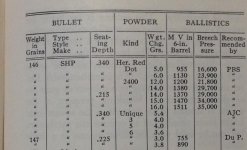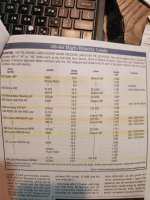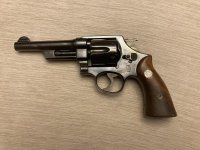Hello all-
Looks like I am going to buy a .38/.44 tomorrow. Four-inch barrel, date of manufacture appears (per SCSW) to be 1948/49/50.
Been searching for reloading data and not finding much. None of my (four) reloading manuals mention the .38/.44.
Did a search here, found absolutely zip/slant/doodley-squat. Nothing. Maybe I'm doing it wrong.
Doing some searching on Google, best I can find is that .38/.44 is "kinda/sorta" a "pre-.357 Mag" load. But I don't want to use .357 Mag data to replicate a .38/.44 load as the .38 cases are shorter...
So at this point my choices are:
--Load top-end .38 Spl or .38Spl+P loads. I already own .38 Spl and .357 Mag revolvers, so why bother?
--Find a .357 Mag load using the same bullet and powder and download by, I don't know, 15 or 20% as a starter? Not owning a chrono, this seems a bit dubious.
--Hope to find some actual .38/.44 loads. I have a decent selection of powders (11 different pistol powders) and bullets (125 and 158 gr).
Not looking for nuclear loads, but if I'm going to own an N-frame in .38/.44 I would like to shoot something stouter than a .38 Spl load, or again, why bother?
All input welcomed.
Best, Rich
Should I have posted this in the Reloading partition?
Looks like I am going to buy a .38/.44 tomorrow. Four-inch barrel, date of manufacture appears (per SCSW) to be 1948/49/50.
Been searching for reloading data and not finding much. None of my (four) reloading manuals mention the .38/.44.
Did a search here, found absolutely zip/slant/doodley-squat. Nothing. Maybe I'm doing it wrong.
Doing some searching on Google, best I can find is that .38/.44 is "kinda/sorta" a "pre-.357 Mag" load. But I don't want to use .357 Mag data to replicate a .38/.44 load as the .38 cases are shorter...
So at this point my choices are:
--Load top-end .38 Spl or .38Spl+P loads. I already own .38 Spl and .357 Mag revolvers, so why bother?
--Find a .357 Mag load using the same bullet and powder and download by, I don't know, 15 or 20% as a starter? Not owning a chrono, this seems a bit dubious.
--Hope to find some actual .38/.44 loads. I have a decent selection of powders (11 different pistol powders) and bullets (125 and 158 gr).
Not looking for nuclear loads, but if I'm going to own an N-frame in .38/.44 I would like to shoot something stouter than a .38 Spl load, or again, why bother?
All input welcomed.
Best, Rich
Should I have posted this in the Reloading partition?
Last edited:




